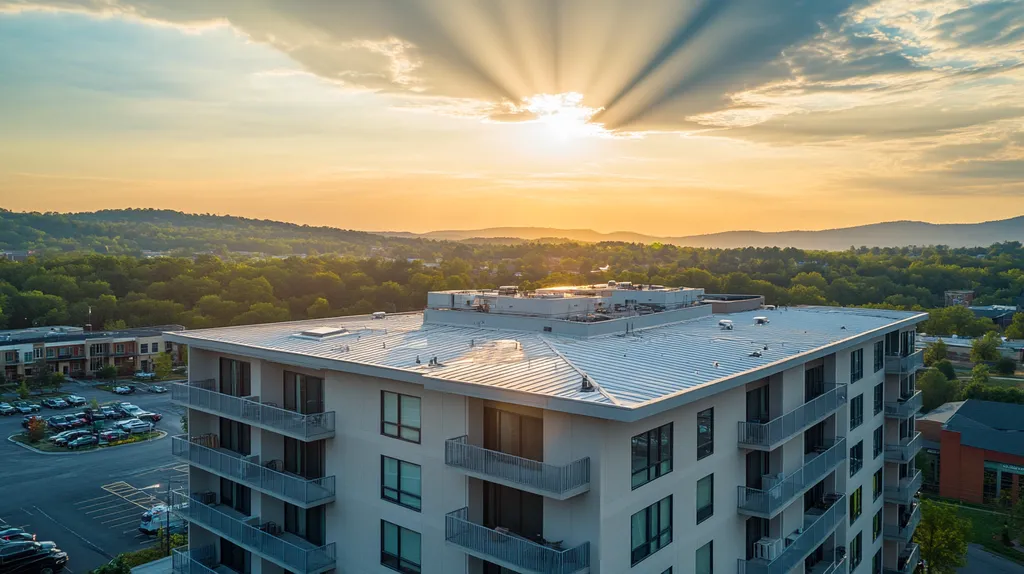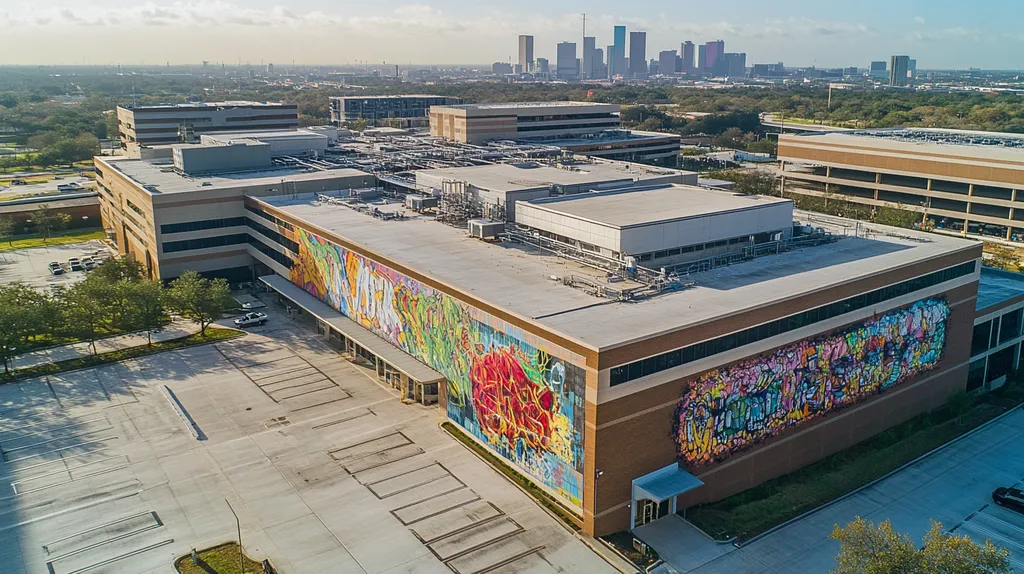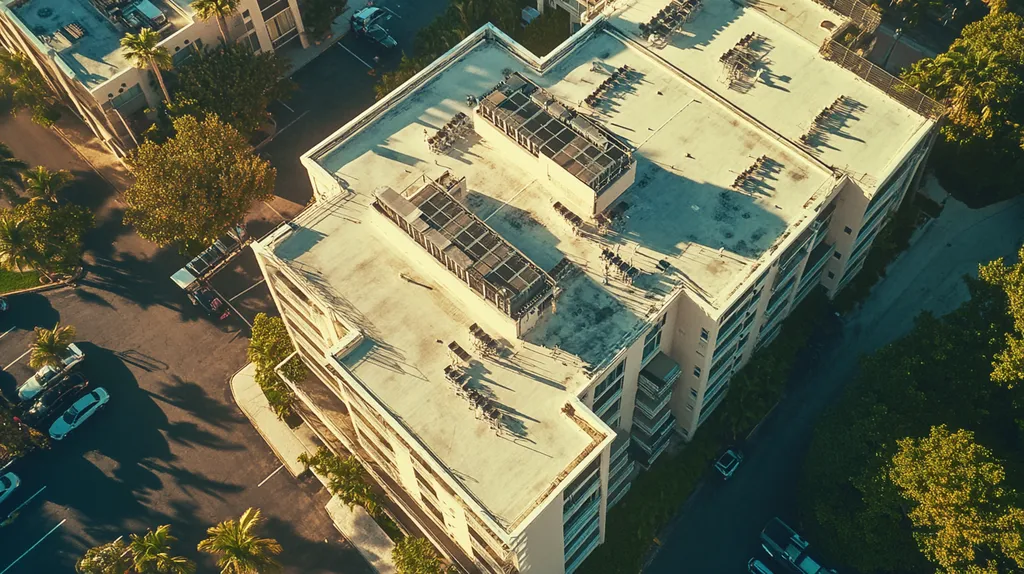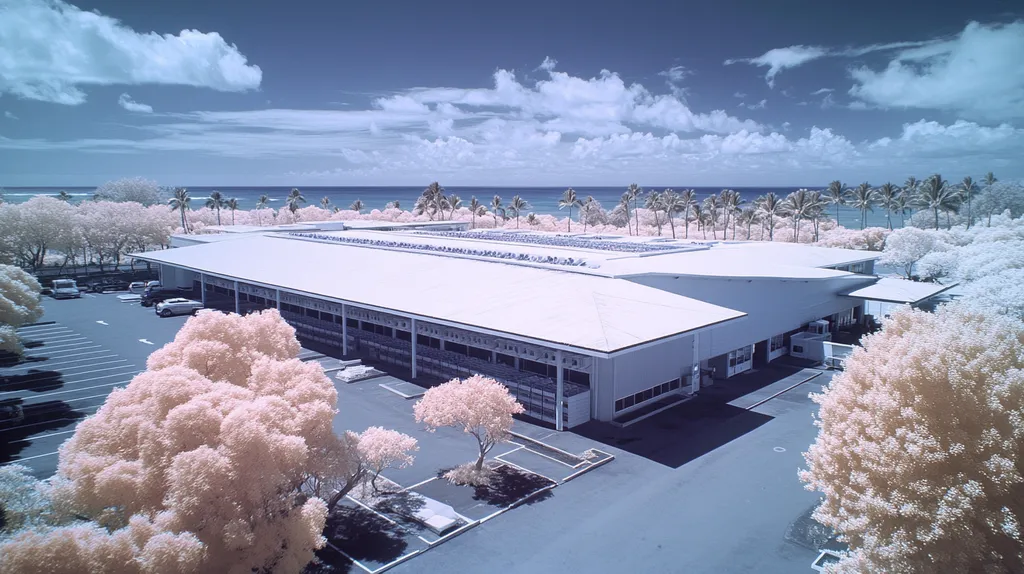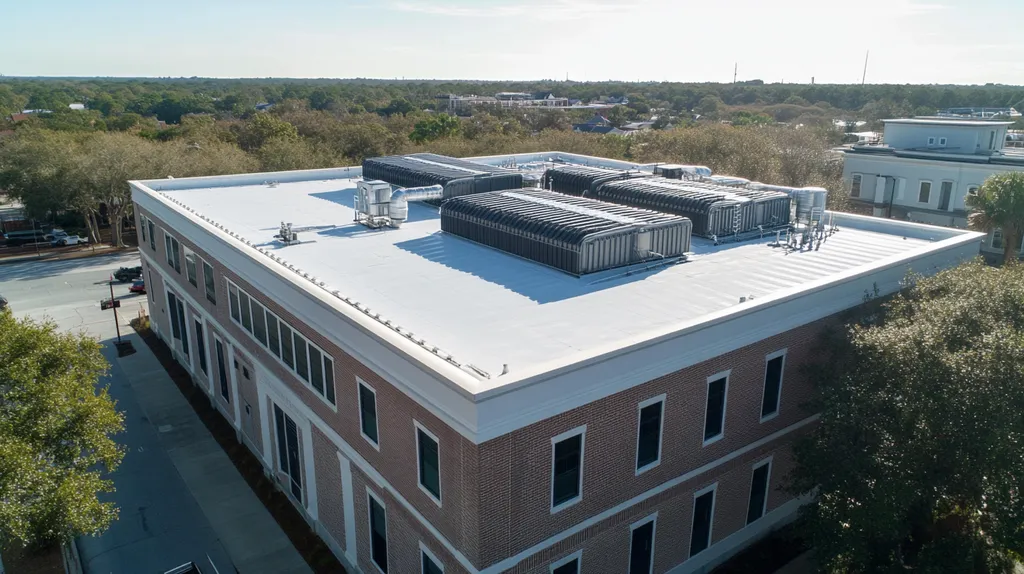In commercial roofing, inadequate sealing practices lead to over $1.5 billion in annual damage across North America, with 40% of all roof failures traced directly to compromised seals around mounted systems.
For property owners and facility managers, understanding proper sealing methods isn’t just about maintenance—it’s about protecting valuable assets and preventing costly business interruptions.
This comprehensive guide examines essential aspects of commercial roof sealing, from material selection and implementation techniques to maintenance protocols and performance metrics, providing actionable insights for optimal system protection.
SECTION 1: FUNDAMENTAL CONCEPTS
Grasping the fundamental concepts of seals for commercial roof-mounted systems is essential for property owners and facility managers. Robust seals not only guard against water intrusion but also mitigate the risk of costly repairs and unsafe conditions. Alarmingly, nearly 20% of commercial roof failures can be traced back to inadequate sealing practices. In this section, we will delve into the various types of sealants available, explore the critical importance of material compatibility, and discuss vital environmental considerations that influence roofing choices.
Types of Roof Sealants
There are a variety of roof sealants utilized in commercial roofing projects, each designed for specific materials and applications. The most common types include silicone, polyurethane, and acrylic sealants, each with unique benefits.
Silicone sealants stand out for their exceptional UV stability and water resistance. They create a reliable, long-lasting barrier against moisture but may struggle to adhere to roofs subject to heavy foot traffic.
Polyurethane sealants, on the other hand, excel in adhesion and flexibility, making them a top choice for metal roofing. They can endure significant movement and stress, ensuring long-term durability.
Acrylic sealants, though less flexible, are praised for their ease of use and affordability. They work well on low-slope roofs but may require more frequent maintenance than their silicone or polyurethane counterparts.
Material Compatibility
Choosing the right sealant hinges on understanding material compatibility within your roofing system. Using incompatible sealants can lead to premature failures and costly repairs down the line. It’s crucial to be aware of the roofing material that requires sealing.
For example, applying a silicone sealant on TPO or PVC roofs can result in poor adhesion. In such instances, a polyurethane product typically provides a more reliable seal.
It’s also essential to verify compatibility with existing components, such as insulation and flashing. Doing so prevents unforeseen complications during installation and significantly extends the lifespan of the roofing system.
Regular evaluations of existing sealants for compatibility can yield long-term savings. As roofing materials age and evolve, adjustments might be necessary to maintain an effective seal.
Environmental Considerations
Environmental factors significantly influence the performance of roof seals. Fluctuating temperatures, humidity levels, and UV exposure can dramatically affect sealant efficacy. Choosing a sealant suited to the specific climate of the building’s location is not just important—it is essential.
For areas experiencing extreme temperature variations, select sealants with high thermal stability. Products designed to flex and contract without losing adhesion can help avert potential failures.
Additionally, adhering to environmental regulations can guide the choice of sealants. Many regions are shifting toward low-VOC (volatile organic compounds) products to support sustainability efforts. Utilizing compliant materials can also lead to reduced maintenance costs over time.
Evaluating both immediate and long-term environmental impacts of roofing decisions is crucial. Careful selections can prevent expensive leaks, enhance the roof’s lifespan, and ensure compliance with regulations.
SECTION 2: SYSTEM COMPONENTS
Effective management of commercial roof-mounted systems hinges on understanding their key components. The choice of roofing materials and sealants is not merely a technical decision; it is a critical factor that influences durability and operational efficiency. Inadequate selections can pave the way for leaks, expensive repairs, and even operational interruptions that can impact a business’s bottom line.
This section will clarify the roles of roofing materials, the characteristics of sealant formulations, and the necessity of compatible substrates. Each element significantly contributes to a roofing system’s overall reliability and effectiveness.
Roofing Materials and Sealants
The selection of roofing materials is paramount for achieving optimal performance in commercial roofing systems. Various materials, such as TPO, EPDM, and PVC, each require specific types of sealants to ensure effectiveness. For example, solvent-based sealants are often necessary for single-ply membranes to achieve robust adhesion.
Additionally, different sealant types behave uniquely under environmental challenges like UV exposure or temperature changes. Silicone sealants, known for their flexibility and resilience, perform admirably in high temperatures, but may struggle with adhesion on certain materials.
Roofing professionals need to carefully assess project specifications before making material and sealant selections. This thorough evaluation not only enhances roof performance but also safeguards the investment made in the commercial property.
Sealant Formulations and Properties
The composition of sealants plays a vital role in determining their effectiveness within roofing systems. Sealants can be divided into categories such as silicone, polyurethane, and acrylic, each with distinct characteristics beneficial for specific applications.
For instance, polyurethane sealants are celebrated for their robust adhesion and flexibility, making them ideal for roofs subject to movement. Conversely, silicone solutions shine in their ability to withstand UV rays, ensuring longevity across varied weather conditions.
By understanding these unique properties, facility managers can make informed decisions when selecting sealants, contributing to improved roof performance and reduced maintenance over time.
Compatible Substrates and Surfaces
The success of a roofing installation heavily relies on the compatibility of sealants with the substrates used. When sealants are mismatched with substrates, adhesion failures are likely, leading to early degradation of the sealant. For example, sealants formulated for metal may not properly adhere to concrete or wood surfaces.
Surface preparation is also crucial for achieving optimal adhesion. Clean and dry surfaces that are free from contaminants provide a solid foundation for sealant application. Skipping this essential step could result in costly repairs down the line.
By understanding the properties of different surfaces, property managers can anticipate potential issues, forging a path toward effective roof management and ultimately enhancing the longevity of roof-mounted systems.
SECTION 3: IMPLEMENTATION METHODS
Applying seals for commercial roof-mounted systems is not merely a task; it is a pivotal measure to prevent leaks and structural damage. Research indicates that nearly 75% of roof failures stem from improper seal installation. Understanding effective implementation methods can drastically improve the longevity and safety of roofing systems, making this section essential for property owners and facility managers.
Surface Preparation Techniques
Proper surface preparation is the cornerstone of effective sealing. Roof surfaces must be meticulously cleaned of dirt, debris, and contaminants that could compromise seal performance. Power washing is a reliable method, paired with industrial-grade cleaners, to ensure a pristine surface.
Before any sealant application, a thorough inspection of the roof for damage or existing leaks is essential. Addressing cracks and punctures beforehand prevents complications. For instance, repairing visible damage enhances the sealing process’s overall effectiveness.
After cleaning, surfaces should dry according to the manufacturer’s guidelines. Any residual moisture can inhibit sealant adhesion, leading to potential future issues. Ensuring surfaces are completely dry maximizes the seal’s lifespan and contributes to the integrity of the entire roofing system.
In summary, investing time in proper surface preparation lays a strong foundation for successful sealing, significantly enhancing the durability of commercial roof-mounted systems.
Application Tools and Methods
The selection of appropriate tools is crucial for proper sealant application. Common tools like caulking guns, rollers, and brushes are designed for different sealant types and surfaces. Mastering the use of these tools leads to a uniform and effective sealant application.
Adhering to manufacturer guidelines regarding sealant thickness and layering is vital. Over-application can result in poor adhesion and failure, while under-application may leave areas vulnerable to leaks.
Using techniques such as back-filling joints and seams promotes a more robust barrier against moisture intrusion. Consistent application not only enhances performance but also spans the roof’s life, ultimately lowering maintenance costs over time.
By implementing these tools and methods with care, facilities can achieve superior sealing performance and protect their roofing systems against future damage.
Curing Time and Conditions
A comprehensive understanding of curing time and its conditions is crucial for ensuring sealant efficacy. Curing is the process where sealants harden and bond with the surfaces beneath. Each type of sealant will have different curing times influenced by factors like temperature and humidity.
Environmental conditions during application play a significant role. For example, applying sealants in rainy or humid weather can prolong curing times and affect adhesion quality. Striving for controlled conditions when possible will yield optimal results.
A key practice is to avoid foot traffic on newly sealed areas until curing is complete. Early disturbance can jeopardize the bond and diminish seal effectiveness.
By strictly observing recommended curing conditions, commercial property owners can maintain the integrity and longevity of their roof-mounted systems, ultimately reducing costs associated with future repairs and replacements.
SECTION 4: MAINTENANCE REQUIREMENTS
Ensuring the seals in commercial roof-mounted systems are properly maintained is vital to preventing severe problems down the line. Neglecting maintenance can lead to leaks, which may result in damages that can cost thousands of dollars and cause significant operational disruptions. Shockingly, about 30% of roof failures are attributed to poor maintenance practices. Therefore, property owners and facility managers need to be proactive about maintenance protocols, timely repairs, and preventive measures. This section breaks down essential maintenance requirements that keep roof systems performing at their best.
Regular Inspection Protocols
Conducting regular inspections is crucial for maintaining the integrity of seals in roof-mounted systems. Experts recommend performing these inspections at least twice a year, especially before and after harsh weather events. Inspections should consist of checking seals for signs of cracks, separation, or general wear, while keeping careful records of findings for future reference.
It is essential to monitor for pooling water or debris accumulation around seals, as these conditions can hasten deterioration. Property owners should develop a detailed checklist that outlines key areas for inspection, ensuring nothing gets overlooked.
Employing trained personnel to carry out these inspections can greatly improve the accuracy and effectiveness of the process. Experienced inspectors can spot subtle signs of damage that others may miss and recommend timely preventive actions. Regular assessments not only protect warranties but also significantly extend the lifespan of the roofing system.
Finally, maintaining a documented history of inspections is invaluable. This data can support warranty claims and assist in assessing the long-term performance of seals.
Repair and Reapplication Procedures
Timely repairs and reapplication of sealants are critical to keeping a roof system watertight. When inspections reveal damage, immediate action is necessary to prevent further complications. Property owners need to be familiar with best practices for seal repairs, which typically include cleaning the affected area and applying a compatible sealant.
Faded or worn seals should be reapplied to restore their protective qualities. Selecting high-quality sealants that align with the original materials is crucial for effective reapplication. Being proactive about resealing can thwart water intrusion and help avoid costly repairs later on.
Keeping records of repairs is essential for tracking maintenance history and material lifespans, aiding future maintenance and budgeting decisions.
Hiring professional roofing contractors for repairs ensures that work adheres to industry standards, allowing for a more comprehensive evaluation of any less visible issues.
Preventive Maintenance Strategies
Adopting preventive maintenance strategies can drastically reduce the likelihood of seal failures. Regularly scheduled maintenance tasks should include clearing debris and ensuring proper drainage on roof surfaces. A proactive approach helps minimize the wear and tear on seals caused by water pooling or accumulated weight.
Creating a maintenance calendar can be an effective way to outline inspection and repair schedules. This calendar serves as a valuable reminder for property managers, keeping roof maintenance front and center.
Utilizing modern technology can further enhance preventative measures. For instance, thermal imaging can help identify hidden issues such as heat loss or moisture accumulation, catching potential seal failures before they escalate.
Lastly, educating staff about the importance of roof maintenance fosters a culture of vigilance. Training employees to recognize warning signs allows for timely reporting and informed interventions.
SECTION 5: PERFORMANCE METRICS
The performance of roof-mounted systems is critical for safeguarding commercial properties. A compromised seal can lead to significant leakage, costly repairs, and extended downtime. Alarmingly, research indicates that over 50% of roofing failures stem from inadequate sealing practices. Understanding vital performance metrics such as durability, water resistance, and UV resilience is essential for making informed decisions. This section explores these important performance indicators and their impact on roof longevity and functionality.
Durability and Longevity Standards
Choosing seals with exceptional durability is essential for prolonging the life of roof-mounted systems. Materials must endure various stressors, including temperature swings and physical impact. High-performance rubber or silicone seals tend to outlast standard options, ensuring a lasting protective barrier.
Standards set by organizations like ASTM outline metrics to gauge durability. These guidelines assist property owners in identifying seals that can stand up to harsh conditions without deteriorating. Overlooking these standards can lead to premature seal failure, escalating maintenance expenses.
Property managers should also consider seals tailored for specific climatic conditions. In areas prone to extreme weather, opting for specialized materials can significantly enhance durability. For instance, seals designed for high-heat environments resist softening, while those for colder climates maintain necessary flexibility.
Regular inspections of seal integrity should be incorporated into maintenance routines. Early detection of wear can avert complex and costly repairs. Proactively addressing durability concerns ensures roofs remain watertight and functional for many years.
Water Resistance and Leak Testing
Water resistance is a crucial performance metric for evaluating the effectiveness of roof seals. Seals must form an impermeable barrier against water intrusion; even minor leaks can cause significant damage. Conducting leak tests during installation helps ensure that seals function as intended.
Industry-standard tests, like ASTM D870, gauge water resistance levels, simulating real-world conditions to verify that seals will maintain integrity under standing water. Property owners should prioritize these assessments prior to finalizing installations to mitigate future risks.
Ongoing evaluations are equally important. Utilizing technologies like infrared thermography can help detect hidden leaks before they manifest visibly. This proactive strategy facilitates timely interventions, lowering maintenance costs and boosting system reliability.
Neglecting water resistance can result in severe repercussions, such as mold growth and structural damage. Implementing rigorous water resistance metrics protects the property and enhances occupant safety. A reliable seal leads to reduced operational risks and increased peace of mind for property owners.
UV Resistance and Weathering
UV resistance plays a vital role for seals exposed to direct sunlight. Ultraviolet rays can degrade standard materials over time, leading to brittleness and seal failure. Opting for UV-resistant seals ensures a longer-lasting roof, especially in sunny climates.
Testing methods like ASTM G154 assess how materials respond to UV exposure. Understanding how long a seal can last under intense sunlight helps property owners make informed choices, minimizing future repair needs.
Seals should also be evaluated for overall weathering performance; different materials offer varying degrees of resistance to rain, snow, and wind. Selecting seals engineered for diverse weather conditions enhances durability and efficacy over time.
Effectively managing UV and weathering factors not only prolongs a seal’s lifespan but also optimizes roof energy efficiency. A robust roof that performs well under UV stress will reflect more heat, reducing energy costs. Investing in UV-resistant seals is a wise and practical choice for commercial properties.
SECTION 5: PERFORMANCE METRICS
The performance of roof-mounted systems is crucial to the success of commercial properties. A faulty seal can open the door to leaks, extensive damage, and costly downtime. In fact, studies show that over 50% of roofing failures are linked to inadequate sealing practices. Understanding key performance metrics—such as durability, water resistance, and UV resilience—is essential for informed decision-making. This section will explore these vital indicators to enhance the reliability of your roofing systems.
Durability and Longevity Standards
Choosing seals that boast high durability is essential for extending the lifespan of roof-mounted systems. These materials must be robust enough to endure a variety of stressors, including temperature changes and physical impacts. Seals crafted from high-performance rubber or silicone typically outlast standard options, offering a dependable long-term protective barrier.
To gauge durability, organizations like ASTM set guidelines that assist property owners in selecting suitable seals that can resist harsh conditions without degrading. Ignoring these standards can lead to premature seal failures and inflated maintenance costs.
Additionally, property managers should choose seals engineered for specific climate conditions. In regions with extreme temperatures, specialized materials, such as high-heat resistant seals, can provide significantly improved durability, preventing issues like softening or brittleness in harsh cold.
Regular inspections of seal integrity should become a routine aspect of roof maintenance. Early detection of signs of wear can prevent costly repairs and ensure that roofs remain watertight and operational for years to come.
Water Resistance and Leak Testing
Water resistance serves as a critical metric when evaluating the effectiveness of roof seals. It is important that seals form an impermeable barrier against water intrusion, as even the smallest leaks can lead to substantial damage. Conducting leak tests during installation is essential to confirm that seals meet performance specifications.
Standards such as ASTM D870 test water resistance levels by simulating real-world conditions. These assessments ensure that seals maintain integrity when exposed to standing water, allowing property owners to identify potential issues before they escalate.
In addition to initial testing, ongoing evaluations are key. Technologies like infrared thermography can uncover hidden leaks before they become visible, enabling timely interventions that reduce maintenance costs and bolster overall system reliability.
Overlooking water resistance metrics can have dire consequences, including mold growth and structural degradation. Implementing these rigorous standards protects both property and occupants, fostering a safe and financially sound commercial environment.
UV Resistance and Weathering
UV resistance is a crucial consideration for seals exposed to direct sunlight. Prolonged UV exposure can degrade standard materials, leading to brittleness and seal failure. By selecting UV-resistant seals, property owners can ensure a longer-lasting roof system, particularly in sunny environments.
Testing methods such as ASTM G154 evaluate a material’s ability to withstand UV radiation. Understanding how long seals can last under intense sun exposure helps property owners make informed decisions, minimizing the need for future repairs.
Further, seals should be assessed for their overall performance in various weathering conditions. Different materials provide varying levels of resistance against elements like rain, snow, and wind. Seals tailored for diverse environments enhance durability and effectiveness over time.
Effectively managing UV exposure and weathering not only prolongs a seal’s lifespan but also boosts roof energy efficiency. By selecting robust, UV-resistant materials, property owners can make a wise investment that delivers long-term benefits for their commercial properties.
The Bottom Line
With over $1.5 billion in annual damage traced to inadequate commercial roof sealing, the stakes for proper system implementation have never been higher.
Modern sealing technologies and methods offer unprecedented opportunities to protect valuable assets while maximizing energy efficiency and sustainability.
By following industry-standard protocols for material selection, implementation, maintenance, and performance monitoring, facility managers can extend roof lifespans by 25-40% while reducing annual maintenance costs by up to 30%.
The future of commercial roofing depends on embracing these advanced sealing solutions, with projections showing that proper sealing practices could prevent over 75% of current roof-related failures.
The time to act is now – every day of delayed implementation risks costly damage that could have been prevented.
FREQUENTLY ASKED QUESTIONS
Q. What are the fundamental concepts of commercial roof seals?
A. Understanding the basics of seals is vital for protecting your roof. Robust seals prevent water intrusion and reduce repair costs. Choosing the right sealant based on compatibility with materials and environmental conditions is essential for longevity.
Q. How do roofing materials affect industrial roof sealants?
A. The choice of roofing materials significantly impacts the type of sealants used. Different materials, like TPO or EPDM, require specific sealants for optimal adhesion. Understanding these interactions ensures that your roof performs reliably under various conditions.
Q. What are the best practices for sealing a commercial roof?
A. Effective sealing begins with thorough surface preparation, including cleaning and inspecting for damage. The application must follow manufacturer guidelines regarding thickness and curing time to ensure a durable investment. Proper techniques lead to enhanced roof performance.
Q. How often should I inspect my commercial roof seals?
A. Regular inspections are critical and should occur at least twice a year. Conducting checks before and after severe weather ensures any physical changes to seals are quickly assessed. Documented findings can help manage warranties and enhance long-term performance.
Q. What performance metrics should I consider for commercial roof seals?
A. Key performance metrics include durability, water resistance, and UV resilience. Understanding these factors helps in selecting high-quality materials that meet specific environmental challenges, ultimately prolonging your roof’s life and preventing costly repairs.
Q. How does curing time affect commercial roof seal performance?
A. Curing time is essential for sealant effectiveness. Each sealant has specific curing requirements influenced by environmental conditions. Rushing the process can result in inadequate adhesion, jeopardizing the seal’s performance and leading to leaks and damages.
Q. What should I include in my commercial roofing maintenance plan?
A. A comprehensive maintenance plan should include regular inspections, timely repairs, and preventive measures. Clear debris and ensure good drainage, creating a checklist of key maintenance tasks will help preserve your roof’s integrity and extend its lifespan.

